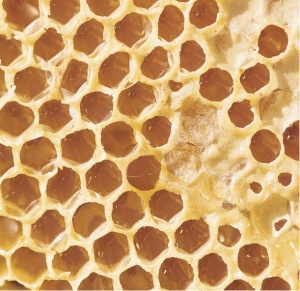 Honeycomb is a waxy, hexagonal structure built by worker honeybees to store honey and pollen, as well as to house developing larvae. The honeybees produce the wax by eating their own honey. Honeycomb has to be removed in order to harvest honey, but it is often returned to the hive to avoid unduly taxing the worker bee’s efforts. Raw honeycomb is eaten, especially with bread, although the nutritional value comes almost exclusively from the honey, pollen and undeveloped larvae within the honeycomb and not from the beeswax.
Honeycomb is a waxy, hexagonal structure built by worker honeybees to store honey and pollen, as well as to house developing larvae. The honeybees produce the wax by eating their own honey. Honeycomb has to be removed in order to harvest honey, but it is often returned to the hive to avoid unduly taxing the worker bee’s efforts. Raw honeycomb is eaten, especially with bread, although the nutritional value comes almost exclusively from the honey, pollen and undeveloped larvae within the honeycomb and not from the beeswax.
Honeybees produce honeycomb in their hives. Composed of beeswax, the structure of honeycomb consists of hexagon-shaped cells used to store honey. The wax that makes up honeycomb contains very-long-chain fatty acids, along with long-chain alcohols, or esters. The honey stored within the honeycomb is the purest, rawest form of honey, and the wax the honeycomb is made of has nutritional value and health benefits.
Benefits Cholesterol
The fatty acids found in fish provide heart health benefits, and so do the very-long-chain fats and alcohols of honeycomb. The fatty alcohols that honeycomb is made of appear to significantly lower bad cholesterol and raise good cholesterol, according to a review published in the March 2004 issue of the journal Experimental Biology and Medicine. In humans, clinical data in one study showed honeycomb fatty acids and alcohols lowered low-density lipoprotein by 21 to 29 percent.
Protects the Liver
The alcohols found in honeycomb appear to have antioxidant effects that help protect your liver. To test this, researchers conducted a study using a mixture of beeswax alcohol to evaluate the safety and effectiveness in people with fatty liver. Participants took a preparation of beeswax alcohol for 24 weeks, and at the end of the study researchers found that it helped normalize liver function and improve symptoms of fatty liver. The study was published in the July 2013 issue of the Korean Journal of Internal Medicine.
Benefits Glucose Metabolism
Glucose is vital to your health, as your body, especially your brain, relies on it for energy. And it appears that the waxy alcohols found in honeycomb promote healthy glucose metabolism. In the fatty liver study, the waxy alcohols in honeycomb significantly reduced insulin levels and markers for insulin resistance in participants. Insulin resistance can lead to type-2 diabetes and other problems.
Don't Go Overboard
It is possible to have too much of a good thing. Follow the honeycomb product's intake guidelines, or consult with a nutrition professional. Eating large amounts of honeycomb may cause gastrointestinal blockage, which is potentially life-threatening. The Cases Journal reports on a woman who landed in the hospital with a large stomach obstruction from eating large amounts of honeycomb over a two-month period. She thought eating large amounts would increase the health benefits. Instead, the honeycomb accumulated in her gastrointestinal tract and formed a large mass that required surgery to remove.
Honeycombs
A honeycomb is made up of hexagonal wax cells built by worker bees, which have to consume over 8 lbs. of honey in order to produce 1 lb. of wax, according to “The Hive and the Honey Bee” by Joe Graham. As such, beekeepers often save the waxy honeycomb after extracting the honey, although artificial honeycombs are used as well, which reduces the workload of the worker bees and allows the beekeeper to sell the honeycomb.
Beeswax
The main constituent of honeycomb is beeswax, which is considered to have no nutrients that can be utilized by people and therefore no caloric value. Eating lots of beeswax may not be good for your digestion as it can’t be broken down in your intestines. Beeswax is commonly sold as a protective balm for skin and lips and is purported to have mild anti-inflammatory effects, according to the book “Nutrition and Wound Healing.”
Honey
Honeycomb is often sold still dripping with honey. Honey is a good source of simple sugars, such as sucrose and glucose, and is easily digested for energy. Unprocessed honey also contains amino acids, digestive enzymes and some B vitamins. Honey is considered a medicinal food because it displays antioxidant and antimicrobial properties that eliminate free-radicals and discourage the growth of microorganisms respectively, according to “101 Foods That Could Save Your Life.”
Bee Pollen and Larvae
Honeycomb also contains some bee pollen and parts of larvae. Bee pollen is a mixture of plant pollen, plant nectar and saliva from worker bees, which contain digestive enzymes. Bee pollen is rich in protein, fiber, fatty acids and B-vitamins, which is why it is marketed as an energy boosting supplement. Although not too appetizing to think about, honeycomb also contains small amounts of undeveloped or dead larvae, which adds to the protein content.
Cautions
If you are allergic to bee stings, eating honeycomb may trigger a negative response, so you should exercise caution and consult with your physician about potential contraindications.

Founder of Lazarus Enterprises Group and head of strategy at Apex Media 365, also Apex Marketing Pro, a leading digital marketing firm.
We developed a system to help small businesses, and local companies connect with potential clients, and customers who truly need their goods or services, which will in-turn increase the company’s net worth with a lot more ease, and control.
We do this utilizing Gorilla marketing tactics, and technology to measure a return on investment.
To schedule a free 30-minute Marketing Tune-up, call us: 1-888-256-4202
